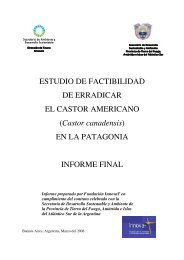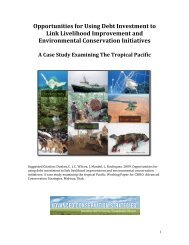Isabela eps:Layout 1 - Advanced Conservation Strategies
Isabela eps:Layout 1 - Advanced Conservation Strategies
Isabela eps:Layout 1 - Advanced Conservation Strategies
You also want an ePaper? Increase the reach of your titles
YUMPU automatically turns print PDFs into web optimized ePapers that Google loves.
MANAGEMENT<br />
& STRATEGY<br />
18<br />
Ground hunting management<br />
Santiago: ground hunter land<br />
Massive areas made manageable<br />
At 58,465 ha Santiago Island is more than 3 times the size of<br />
Washington DC; it is too large for ground hunters or even a<br />
helicopter to work as a single block. The island has no roads or<br />
fences and is over 35 km long and 21 km wide. The division of the<br />
island into 24 blocks for ground hunters allowed the entire island to<br />
be worked systematically. Satellite imagery was used to assess the<br />
island geography; wavelength band combinations were used to<br />
highlight vegetation types and volcanic areas. GPS units were used to mark existing trails throughout the island. Natural<br />
topographic features, easily identified by hunters (e.g., ridgelines, hills, etc), were also identified. Ground hunting blocks<br />
were subdivided into a total of 137 sub-blocks which facilitated the specialized rastrillo ground hunting technique and<br />
provided optimally sized areas for teams of 15 hunters to cover in one day. Sub-blocks in open areas were on average twice<br />
the size of the Principality of Monaco (384 ha) and those in heavily vegetated areas were about 171 ha.<br />
FACT BOX<br />
• Ground hunters: 100% Galapageños<br />
• 20% from <strong>Isabela</strong>, 80% from Santa Cruz<br />
• Highly qualified hunters<br />
- Hunting skills<br />
- GPS handling<br />
- Rifle maintenance<br />
- First aid intervention training<br />
• 147 dogs bred in PI kennel<br />
• 2 qualification levels for dogs<br />
Dogs wearing special leather boots for protecting their<br />
paws when working on lava during hot days.<br />
Not Welcome<br />
While Santiago Island has a good network of trails, several camps<br />
and water collecting sites, <strong>Isabela</strong> Island is far from providing the<br />
same level of hospitality. Moreover, a large proportion of the island<br />
is covered by lava fields and thus large areas of the island are not<br />
practically workable from the ground. Size, remoteness and<br />
complex access are additional factors that make <strong>Isabela</strong> a difficult<br />
island to work on.<br />
Darwin volcano is a good example. Probably the driest of all,<br />
it has around 64% of its area covered by volcanic rocks. Wolf with<br />
its steep slopes and high altitude also offers a big challenge.<br />
Alcedo presents probably the best conditions as well as having a<br />
hut and water collector on the rim. The Linda Cayot hut is<br />
accessible by a moderate climbing trail. The southern part of<br />
<strong>Isabela</strong>, even though it has existing trails and a National Park hut,<br />
offers a challenge, not only because of its size, but also because of<br />
the huge lava fields.<br />
For all these reasons, helicopters were chosen and have proven to<br />
be the best hunting and monitoring tool for tackling <strong>Isabela</strong> Island.<br />
Aerial hunting management<br />
FACT BOX<br />
<strong>Isabela</strong>: helicopter land<br />
• Helicopter model: MD500D/MD500E<br />
• Capacity: 1 pilot and up to 3 passengers<br />
• Airspeed: Hover to 156 knots<br />
• Range: 225 Nautical miles ~2.2 hours @110 knots<br />
• Lifting capacity: 500kg<br />
MANAGEMENT<br />
& STRATEGY<br />
19





